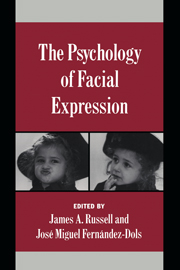Book contents
- Frontmatter
- Contents
- Foreword
- Preface
- Contributors
- Part I Introduction
- Part II Three broad theoretical frameworks
- Part III With a biological and developmental focus
- Part IV With a psychological and social focus
- 10 A Componential Approach to the meaning of facial expressions
- 11 Spontaneous facial behavior during intense emotional episodes: Artistic truth and optical truth
- 12 Is the meaning perceived in facial expression independent of its context?
- 13 Reading emotions from and into faces: Resurrecting a dimensional-contextual perspective
- 14 Facing others: A social communicative perspective on facial displays
- 15 Faces in dialogue
- Part V Integrative summary
- Author index
- Subject index
- Studies in Emotion and Social Interaction
12 - Is the meaning perceived in facial expression independent of its context?
Published online by Cambridge University Press: 11 March 2010
- Frontmatter
- Contents
- Foreword
- Preface
- Contributors
- Part I Introduction
- Part II Three broad theoretical frameworks
- Part III With a biological and developmental focus
- Part IV With a psychological and social focus
- 10 A Componential Approach to the meaning of facial expressions
- 11 Spontaneous facial behavior during intense emotional episodes: Artistic truth and optical truth
- 12 Is the meaning perceived in facial expression independent of its context?
- 13 Reading emotions from and into faces: Resurrecting a dimensional-contextual perspective
- 14 Facing others: A social communicative perspective on facial displays
- 15 Faces in dialogue
- Part V Integrative summary
- Author index
- Subject index
- Studies in Emotion and Social Interaction
Summary
We see infants smile when they encounter an adult. We see adults smile when they watch a slapstick cartoon. We see people weep at homages and funerals. We see teenagers frown when their computers flash a strange message, and teachers frown when a teenager makes an inappropriate remark. Smiles, frowns, and other facial configurations described as “expressions of emotion” are highly meaningful cues in our perception of others.
This chapter concerns the meaning perceived in such facial expressions, and, specifically, whether that meaning depends on the context in which the expression occurs. (By “context” we mean the situational events that surround the facial movement, and we use the words situation and context interchangeably.) Common sense suggests yes. As with any behavior, facial expressions are embedded in a context; they happen at a particular time (e.g., while gazing at someone) and in a particular place (e.g., at a funeral). Psychological wisdom says that any perception is an interaction between the stimulus and its context (between the figure and its ground), and ethologists have found that animal messages get their specific meaning through context (Hinde, 1982; Smith, 1977).
What, then, are the figure–ground interactions between facial expressions and context? The answer implicit in the mainstream view of facial expression is very simple: There are none. Most research on facial expressions presupposes that they have meaning independent of their context or, in other words, that the context plays no essential role in the recognition of emotions from facial expressions. A specific facial expression means happiness, surprise, fear, or whatever, irrespective of the occasion of its occurrence.
- Type
- Chapter
- Information
- The Psychology of Facial Expression , pp. 275 - 294Publisher: Cambridge University PressPrint publication year: 1997
- 22
- Cited by

